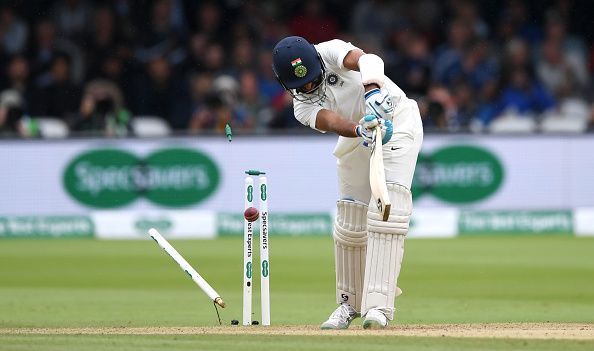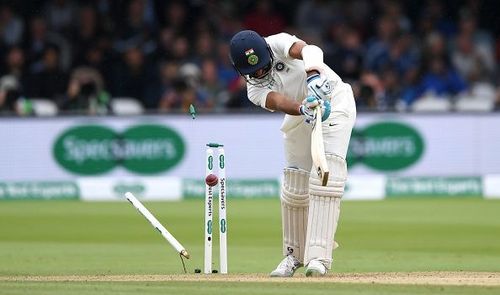
Analyzing the disappointing performances of Indian openers in overseas conditions

The cricketing world has seen some brilliant opening pairs in the history of Test Cricket. Langer-Hayden, Greenidge-Haynes, Strauss-Cook, Atapattu-Jayasuriya, Taylor-Slater, the list is longer than it seems. India, on the other hand, has been in a constant struggle to find a decent pair in the last two decades.
In the first Test at Edgbaston (2018), the Indian openers made a new record, though unwillingly. A record at which no Indian would be proud of. After 7 long years, the Indian openers batted together for more than 10 overs. This is hard to believe, but true.
Blame it on SENA countries
The woes of Indian openers have been the cause of trouble for the team for a very long time. Batting out of the Indian subcontinent, particularly in the SENA countries (South Africa, England, New Zealand and Australia) has proved to be very difficult for the Indian batsmen, especially the openers.
Since the year 2000, only twice before the current series in England, Indian openers lasted for more than 10 overs, while playing in SENA countries. The first one was during the Brisbane Test in 2003 against Australia and the second during the Lord’s Test in 2011.
During the Brisbane Test, Sehwag and Akash Chopra added 61 runs for the first wicket, before Sehwag was out in the 20th over, falling five short of a well-deserved half-century. The second instance was against England at Lord’s where Abhinav Mukund and Gautam Gambhir opened the innings and the stand was broken when Gambhir got out in 19th over.
What’s causing the batting to flop?
The problem of the Indian openers getting out easily has many layers to it. If we try to look beyond the opening pair, these issues do impact other batsmen in the line-up as well. Let’s try to understand the causes of such disdain in the past many years.
Tackling the swing
When visiting England as a batsman, one must be prepared to tackle the swing. The Indian batsmen, however, looked totally in denial and showed little respect to the movement in the air.
More often than not, the batsmen were playing from the crease, and not coming out to negate the swing. Whenever they did the opposite, not only runs were scored but the confidence of English bowlers was put to the Test. However, such adaptability was shown only by Kohli and to an extent by Ashwin.
Love for the cross-batted shots
Playing a cross batted shot with little foot movement is like inviting the bowler to rattle your castle or falling down plumb in front of the wicket. These aren’t subcontinent pitches and one mistake is enough to send the batsman back to pavilion.
The fall of Murali Vijay on the fifth ball of 2nd Test was a prime example that a batsman should not go for such a shot so early in the innings, especially when the feet are not moving quickly enough. Pujara in the 2nd innings of the Lord’s Test made the same mistake after batting patiently for 87 deliveries and paid the price.
Why is it necessary to poke at everything?
Most of the batsmen poked at the ball going away to 4th or 5th stump. Leaving such kind of balls put pressure on the blower. Such temperament, not only saves the day for the team but also gives the batting side a psychological advantage, which plays a crucial role in the Test cricket.
The problem was not only with the openers, but other batsmen as well. Rahul, Pandya or Rahane got out in the same way in all four innings.
Body language and adaptability
The body language of Indian openers was not great when they walked into the middle in the second innings of the second Test. Having gone through the trauma of the first Test and the overcast conditions on the second day of the second Test made them feel skeptical about their fate.
They could have taken a leaf out of Ganguly’s booklet, when he scored a majestic 144 in the Brisbane Test (2003) and gave Australians a fitting reply or when Sachin scored a masterful 241 (not out) in the Sydney Test (2004). In that innings, Sachin scored almost every single run on the on-side, as he was getting out frequently while playing on the off-side.
Most Indian batsmen are currently out of form and hence they are looking to score more and more runs. They are not playing the ball on its merit, which is badly hampering India’s chances of making a comeback in the series.
Where is the variety?
The only Southpaw in Indian Test line-up was Shikhar Dhawan who was shown the door after the failure in the first Test. Having a couple of left-handed batsmen in the team provides an advantage and more often than not helps in unsettling the bowler’s line and length.
It is time that the Indian team should look at giving Rishabh Pant a chance. He is a young blood, an excellent stroke maker, a wicket-keeper and more importantly plays left hand.
What could be the next steps?
The selectors should take a note of the players who are not performing consistently overseas and try to give youngsters a chance.
Show the videos to the players who get out in the same way every time and when they throw their wicket away. Hold them responsible. Players cannot make mistakes and laugh it off on the field.
Practice with the bowling machine that generates artificial swing.
The dedication and commitment that a batsman shows through his body language, does transpire to his batting and the rest of the team as well. It is time that the Indian team must show the world that why they deserved to be called as the number one Test team.